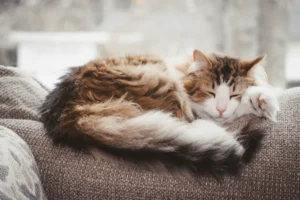Cats can be very vocal creatures, crying out for attention in various ways. But why do they do this? Let’s explore the reasons behind why cats cry for attention.
Cats are known for their independent nature, but they also crave attention and interaction with their human companions. Crying for attention is a way for cats to communicate their needs and desires. Here, we will delve into the reasons behind this behavior and how to respond effectively.
Understanding the Instincts of Cats
Cats are unique creatures with instincts deeply rooted in their DNA. One of the primary instincts that drive them to seek attention from their owners is their natural desire for companionship. In the wild, cats are solitary hunters, but they still crave social interaction. When domesticated, this instinct translates into seeking attention from their human companions.
Another critical instinct is their need for security and safety. Cats are territorial animals, and they view their owners as part of their territory. By seeking attention, they are not only looking for companionship but also reassurance that they are safe and protected in their environment.
Understanding these instincts can help us better cater to our cats’ needs and provide them with the attention and comfort they seek.
Signs Your Cat is Crying for Attention
Learning to recognize the signs that your cat is seeking attention is essential for maintaining a healthy and happy bond with your feline friend. One common indicator is vocalizations – if your cat is meowing more than usual, it could be their way of trying to communicate with you and seek your attention.
Body language cues are also crucial to pay attention to. For example, if your cat rubs against you, kneads on your lap, or follows you around the house, these are all signs that they are craving your attention and affection.
By being mindful of these signs, you can respond to your cat’s needs promptly and strengthen your relationship with them.
And remember, every cat is unique, so it’s essential to observe and understand your cat’s specific cues for attention-seeking behavior.
The Importance of Mental Stimulation
Have you ever wondered why cats cry for attention? Well, one major reason could be a lack of mental stimulation. Cats are curious creatures that thrive on exploration and play. When they don’t get enough mental stimulation, they may resort to crying for attention as a way to seek out interaction and engage their minds.
Providing your feline friend with the right kind of attention can greatly benefit their overall well-being. Interactive toys, scratching posts, and puzzle feeders are great ways to keep your cat mentally stimulated and content. Engaging your cat in playtime and interactive activities not only keeps them entertained but also helps prevent behavioral issues that may arise from boredom.
Remember, a stimulated cat is a happy cat. By catering to their need for mental stimulation, you can help reduce their cries for attention and create a harmonious environment for both you and your furry companion.
Additional Unique Insight:
- Consider Rotating Toys: Cats can get bored easily, so rotating their toys every few days can keep them engaged and excited about playtime.
Creating a Bond Through Interaction
When it comes to understanding why cats cry for attention, it’s essential to recognize the importance of interaction in building a strong bond with your pet. Cats are social animals that crave companionship and connection with their owners. By engaging with your cat regularly, you not only fulfill their need for attention but also strengthen the bond between the two of you.
Interacting with your cat can take many forms, from engaging in play sessions to simply spending quality time together. Grooming, petting, and talking to your cat can all help build trust and create a sense of security for your furry friend. These interactions go a long way in showing your cat that they are loved and cared for, ultimately reducing their cries for attention.
So, next time your cat cries for your focus, remember that a little interaction can go a long way in fostering a deep and meaningful connection with your feline companion.
Interaction Tips:
- Set Aside Quality Time: Dedicate a few minutes each day to interactive play or cuddle sessions with your cat to strengthen your bond.
- Use Positive Reinforcement: Reward good behavior with treats or gentle praise to encourage positive interactions.
Addressing Attention-Seeking Behavior
Does your feline friend constantly meow for attention? While it can be endearing, excessive attention-seeking behavior in cats may indicate underlying issues. Redirect their focus by providing interactive toys or puzzles to keep them entertained. Establish a routine for feeding, playtime, and grooming to create a sense of predictability. Remember, consistency is key in modifying behavior. If the behavior persists, consult with your veterinarian to rule out any medical concerns.
Engaging Playtime Activities
Looking for fun ways to keep your cat stimulated and satisfied? Engage them in interactive playtime activities like feather wands, laser pointers, or puzzle feeders. These activities not only provide mental stimulation but also fulfill their natural hunting instincts. Set aside dedicated play sessions each day to strengthen your bond and keep them physically active. Remember, a tired cat is a happy cat! And don’t forget to incorporate vertical spaces like cat trees for climbing and exploration.
Engaging Playtime Activities: 1. Feather wands: Stimulate your cat’s natural hunting instincts with a feather wand toy. 2. Laser pointers: Keep your cat entertained by chasing the elusive red dot from a laser pointer. 3. Puzzle feeders: Challenge your cat’s problem-solving skills by using puzzle feeders to dispense treats.
Remember, understanding your cat’s behavior is key to addressing their needs effectively. By providing a stimulating environment and engaging playtime activities, you can help curb attention-seeking behavior and promote a healthier relationship with your feline companion. For more tips on cat behavior, consult reputable sources like the American Association of Feline Practitioners.
Providing a Safe and Comfortable Environment
Creating a safe and comfortable environment for your cat is crucial in reducing attention-seeking behaviors. Cats may cry for attention when they feel anxious, bored, or insecure. Ensure your feline friend has a designated space with cozy bedding, a scratching post, and toys to keep them entertained. Providing vertical spaces like cat trees or shelves can also give them a sense of security and territory. Consider leaving out puzzle feeders or interactive toys to stimulate their minds and prevent them from seeking attention out of boredom. Additionally, make sure your cat has access to fresh water, a clean litter box, and a quiet area for rest. By addressing their basic needs and offering a peaceful environment, you can help minimize their cries for attention.
Fun Facts About Cat Behavior
Did you know that cats have a variety of vocalizations to communicate their needs and emotions? Understanding these quirks can improve your bond with your furry companion. Contrary to popular belief, cats don’t only meow at humans – they also meow at each other! Their meows can range from short and high-pitched to long and low-pitched, each conveying a different message. Pay attention to your cat’s body language along with their vocal cues to decipher what they’re trying to tell you. Cats purr not only when they’re content but also when they’re stressed or in pain as a self-soothing mechanism. By learning to interpret your cat’s vocalizations and behaviors, you can better respond to their needs and strengthen your relationship with them.
- Unique Insight: Cats may cry for attention as a way to manipulate their humans. They quickly learn that meowing can get them what they want, whether it’s food, playtime, or affection. By being consistent with your responses and not rewarding attention-seeking behavior, you can help curb excessive crying for attention. Setting boundaries and providing positive reinforcement for desired behaviors can encourage your cat to communicate more effectively without resorting to constant meowing.
Alex, a passionate animal lover, has experience in training and understanding animal behavior. As a proud pet parent to two dogs and three cats, he founded AnimalReport.net to share insights from animal experts and expand his knowledge of the animal kingdom.




